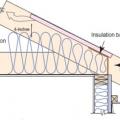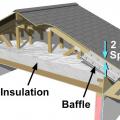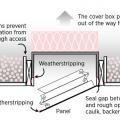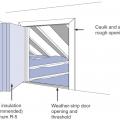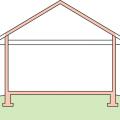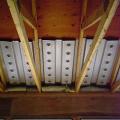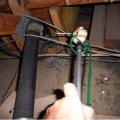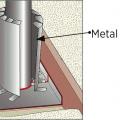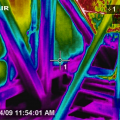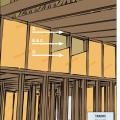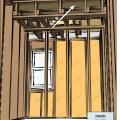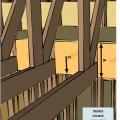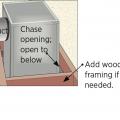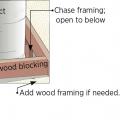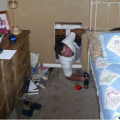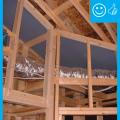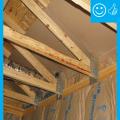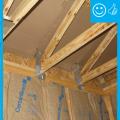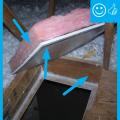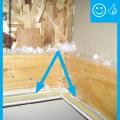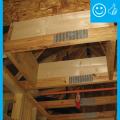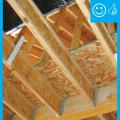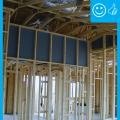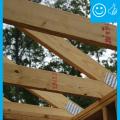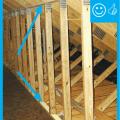Showing results 1 - 50 of 78
A 1- and ½-story home with a room located in the attic and the thermal boundary located at either a) the walls and ceiling of the attic room with small vented attic spaces or b) the roof line for an unvented attic
A low-sloped shed roof with the thermal boundary located at either a) the flat ceiling with a vented attic or b) the roof line for an unvented attic
A site-built rafter roof with a raised top plate allows for more insulation underneath.
After all holes through the ceiling are air-sealed and the baffles have been installed, then the insulation can be installed.
An unvented cathedralized attic has the air, thermal, and vapor control layers at the roof line
Baffles provide an air space over the insulation to guide ventilation air from the soffit vents up along the underside of the roof deck
Design the roof with raised heel trusses to allow full insulation over the top plates of the exterior walls.
Failure in attic insulation effectiveness caused by wind washing pushing insulation away from the edges of the attic space.
Flat roof with cavity spray foam plus loose-fill insulation and gypsum board thermal barrier.
Floor cavity air pressure is measured by placing a tube into the floor cavity through a small drilled hole
Floor cavity pressure is measured by inserting a tube into the floor cavity using an extension pole
In cathedral ceilings, parallel chord trusses allow thicker insulation levels over the exterior wall top plates.
Infrared imaging shows cold conditioned air pouring out of the open floor cavities under this attic kneewall into the hot unconditioned attic
Install a continuous air barrier below or above ceiling insulation and install wind baffles.
Install insulation under platforms constructed in the attic for storage or equipment.
Install wood framing cross pieces in the attic rafter bays on each side of the duct chase
Install wood framing cross pieces in the attic rafter bays on each side of the duct chase
Limited attic access can make inspections for missing air barriers and insulation challenging
Limited attic access may make it necessary to use a bore scope when inspecting for missing air barriers and insulation in existing buildings.
Raised heel energy trusses extend past the exterior wall and are deeper at the wall allowing room for full insulation coverage over the top plate of the exterior walls.
Right - Air barrier is present between the dropped ceiling/soffit and the attic.
Right - Air barrier is present between the dropped ceiling/soffit and the attic.
Right - Continuous wall sheathing and blocking has been installed to brace the raised heel trusses.
Right - Wind baffle installation will allow proper insulation depth over the top plate.
Right – Attic access hatch has been properly insulated by attaching a fiberglass batt, gasketed, and opening has blocking
Right – Attic access door has foam and rubber weatherstripping installed that remains in contact when closed.
Right – Blocking has been installed around the perimeter of this attic access to prevent insulation falling into the house
Right – Insulation installed to correct depth and will be aligned with air barrier
Right – This attic knee wall and the floor joist cavity openings beneath it are being sealed and insulated with spray foam.
Right – Wind baffle installation maintains necessary code clearance between baffle and roof deck
Right-- IR photo shows how effectively spray foam insulated/air sealed attic kneewall and the floor cavities under kneewall



